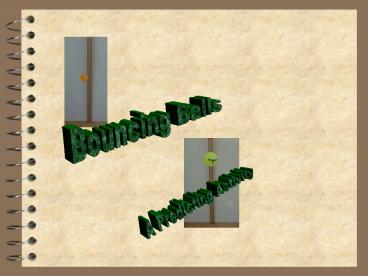Bouncing Balls - PowerPoint PPT Presentation
1 / 12
Title:
Bouncing Balls
Description:
Be sure to have read the materials on the Science Processes. ... ability (pictured are a ping pong ball, a racquet ball, and a tennis ball.) Two meter sticks. ... – PowerPoint PPT presentation
Number of Views:1933
Avg rating:3.0/5.0
Title: Bouncing Balls
1
Bouncing Balls
A Predicting Activity
2
Bouncing Balls
- This activity provides experience in making
predictions. - It also provides experience in dealing with
- observation
- charting and graphing (communication skills)
- operational definitions
- and using numbers
3
Bouncing Balls
- Be sure to have read the materials on the Science
Processes. - Complete each slide before moving on to the next.
- Answer all questions posed throughout the
activity.
4
Materials Needed
- Three balls with good bouncing ability (pictured
are a ping pong ball, a racquet ball, and a
tennis ball.) - Two meter sticks.
- Tape.
- Writing materials.
5
Step 1
- Tape the meter sticks to the wall with the 0
end resting on the floor.
6
Design Table 1 (Your table should look something
like the one below.)
Step 2
Click here for some music while you make your
Table.
7
Step 3
- Select the first ball and drop it from each of
the drop heights listed on your table. - You need to operationally define drop ht in terms
of the part of the ball that is held at each
distance from the floor. Center of the ball? Top?
Bottom?
8
Step 4
- Drop the ball and record the bounce ht on your
table. - You will need to observe carefully to get an
accurate bounce ht. - Repeat this step until you have 3 accurate
observations for each of the drop hts. Average
them for your recorded bounce ht. - Repeat this step for each ball.
9
Design Table 2
Step 5
- Based upon the data from Table 1 what predictions
would you make about the bounce heights of the
three balls if the drop heights were changed? - In Table 2 (next slide) the drop heights have
been changed plus the bounce height columns have
been split to allow you to make predictions
before dropping the balls from the new heights. - For each ball at each new drop ht. make a
prediction about its bounce and record it. Then
test your prediction by observing the bounce when
dropped from the new height. Note! Do this one
cell at a time. Make one prediction then test it
before making your next prediction. - Test your predictions by using the same procedure
as in Table 1 including 3 observations for each
drop height .
10
Table 2 Predicted/Observed Bounce Hts.
Click here for some funky table-making music.
11
Step 6
- Post answers on the discussion board to the
following questions - 1. Did your ability to predict the bounce heights
get better with practice? Why? - 2. Were any of the balls, or heights, easier to
predict than others? Develop and list inferences
to account for the differences. - 3. Observations of natural events are sometimes
difficult to make (scientists refer to this as
measurement error ). What procedure(s) did
we use to try to correct for measurement error? - 4. Can you identify how we used the process
skills of Communication?
12
This activity is completed! So relax for a moment
or two.































